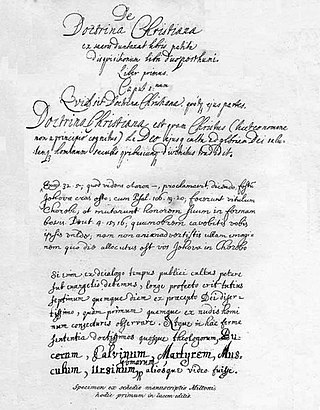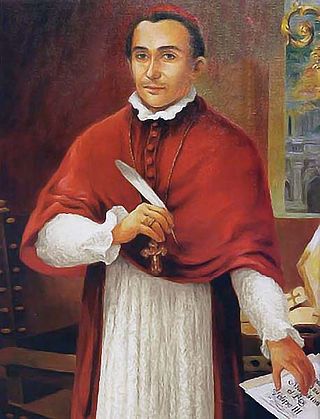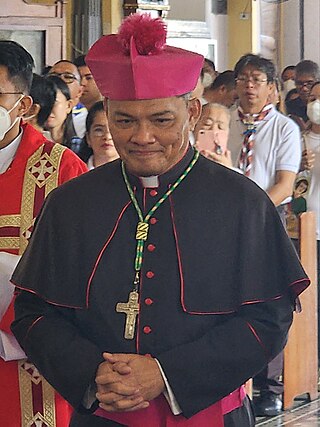Diego Aduarte OP was a Spanish Dominican friar and historian. He was a missionary to the Philippine Islands and arrived there in 1595 with Blancas de San Jose. In 1632 was made Prior of Manila. He died in 1636.

A catechism is a summary or exposition of doctrine and serves as a learning introduction to the Sacraments traditionally used in catechesis, or Christian religious teaching of children and adult converts. Catechisms are doctrinal manuals – often in the form of questions followed by answers to be memorised – a format that has been used in non-religious or secular contexts as well. According to Norman DeWitt, the early Christians appropriated this practice from the Epicureans, a school whose founder Epicurus had instructed to keep summaries of the teachings for easy learning. The term catechumen refers to the designated recipient of the catechetical work or instruction. In the Catholic Church, catechumens are those who are preparing to receive the Sacrament of Baptism. Traditionally, they would be placed separately during Holy Mass from those who had been baptized, and would be dismissed from the liturgical assembly before the Profession of Faith and General Intercessions.

The Catholic Bishops' Conference of the Philippines (CBCP) is the permanent organizational assembly of the Catholic bishops of the Philippines exercising together certain pastoral offices for the Christian faithful of their territory through apostolic plans, programs and projects suited to the circumstances of time and place in accordance with law for the promotion of the greater good offered by the Catholic Church to all people.

Philippine Hokkien is a dialect of the Hokkien language of the Southern Min branch of Min Chinese descended directly from Old Chinese of the Sinitic family, primarily spoken vernacularly by Chinese Filipinos in the Philippines, where it serves as the local Chinese lingua franca within the overseas Chinese community in the Philippines and acts as the heritage language of a majority of Chinese Filipinos. Despite currently acting mostly as an oral language, Hokkien as spoken in the Philippines did indeed historically have a written language and is actually one of the earliest sources for written Hokkien using both Chinese characters as early as around 1587 or 1593 through the Doctrina Christiana en letra y lengua china and using the Latin script as early as the 1590s in the Boxer Codex and was actually the earliest to systematically romanize the Hokkien language throughout the 1600s in the Hokkien-Spanish works of the Spanish friars especially by the Dominican Order, such as in the Dictionario Hispanico Sinicum (1626-1642) and the Arte de la Lengua Chiõ Chiu (1620) among others. The use of Hokkien in the Philippines was historically influenced by Philippine Spanish, Filipino (Tagalog) and Philippine English. As a lingua franca of the overseas Chinese community in the Philippines, the minority of Chinese Filipinos of Cantonese and Taishanese descent also uses Philippine Hokkien for business purposes due to its status as "the Chinoy business language" [sic]. It is also used as a liturgical language as one of the languages that Protestant Chinese Filipino churches typically minister in with their church service, which they sometimes also minister to students in Chinese Filipino schools that they also usually operate. It is also a liturgical language primarily used by Chinese Buddhist, Taoist, and Matsu veneration temples in the Philippines, especially in their sutra chanting services and temple sermons by monastics.

As part of the worldwide Catholic Church, the Catholic Church in the Philippines, or the Philippine Catholic Church or Philippine Roman Catholic Church, is part of the world's largest Christian church under the spiritual leadership of the Pope in Rome. The Philippines is one of the two nations in Asia having a substantial portion of the population professing the Catholic faith, along with East Timor, and has the third largest Catholic population in the world after Brazil and Mexico. The episcopal conference responsible in governing the faith is the Catholic Bishops' Conference of the Philippines (CBCP).

Pieter van der Moere, also known as Brother Pedro de Gante or Pedro de Mura was a Franciscan missionary in sixteenth century Mexico. Born in Geraardsbergen in present-day Belgium, he was of Flemish descent. Since Flanders, like Spain, belonged to the Habsburg Empire and he was a relative of King Charles V, he was allowed to travel to the colonies of New Spain as one of a group of Franciscan friars. Gante's group in fact arrived before the 12 Franciscans normally thought of as the first friars in New Spain. In Mexico he spent his life as a missionary, teaching the indigenous population in Christian catechism and dogma. He learned Nahuatl, the language of the Aztecs, and composed a Christian "doctrina". One of his most significant contributions to Mexico was the creation of the School of San Jose de los Naturales. This was the first school set up by Europeans in the Americas.
The Third Council of Lima was a council of the Roman Catholic Church in 1582–83 in Lima, at the time the capital of the Spanish Viceroyalty of Peru. It was the most important of the three councils celebrated in Lima during the 16th century, since it definitively organized the Church in the Americas. It was summoned by Archbishop Toribio de Mogrovejo in 1581, and met from 15 August 1582 to 18 October 1583.

Catholic Media Network, also known as CMN, is a Catholic radio network in the Philippines. CMN serves as the broadcasting arm of the Catholic Bishops' Conference of the Philippines, the governing body of the Roman Catholic Church in the Philippines.
Events from the year 1639 in Ireland.

Romulo Geolina Valles, is the current archbishop of the Archdiocese of Davao in Davao City, on the island of Mindanao, Philippines and was the president of the Catholic Bishops' Conference of the Philippines from 2017 to 2021. He was the former archbishop of Zamboanga before being appointed to the Davao see.

De Doctrina Christiana is a theological treatise of the English poet and thinker John Milton (1608–1674), containing a systematic exposition of his religious views. The Latin manuscript "De Doctrina" was found in 1823 and published in 1825. The authorship of the work is debatable. In favor of the theory of the non-authenticity of the text, comments are made both over its content, and it is difficult to imagine that such a complex text could be written by a blind person. However, after nearly a century of interdisciplinary research, it is generally accepted that the manuscript belongs to Milton. The course of work on the manuscript, its fate after the death of the author, and the reasons for which it was not published during his lifetime are well established. The most common nowadays point of view on De Doctrina Christiana is to consider it as a theological commentary on poems.

The Roman Catholic Archdiocese of Tuguegarao is a Latin Church metropolitan archdiocese of the Catholic Church in the Philippines. Tuguegarao is a river delta city that became center of the archdiocese in the province of Cagayan, on the island of Luzon. Its seat is located at the Saint Peter the Apostle Metropolitan Cathedral.
In the Catholic Church, the Precepts of the Church, sometimes called the Commandments of the Church, are certain laws considered binding on the faithful. As usually understood, they are moral and ecclesiastical, broad in character and limited in number. In modern times there are five.

The Roman Catholic Diocese of Tarlac is a diocese of the Roman Catholic Church comprising the whole civil province of Tarlac in the Philippines. The see is the Saint Sebastian Cathedral in Tarlac City.

Miguel de Benavides y Añoza, O.P. was a Spanish Catholic prelate and sinologist who served as the third Archbishop of Manila. He previously served as the first Bishop of Nueva Segovia and was the founder of the University of Santo Tomas in Manila.
Juan Cobo OP was a Spanish Dominican missionary, diplomat, astronomer and sinologist.

University of Santo Tomas Publishing House (USTPH) is a Filipino academic and literary publishing house. USTPH, in its current form, was established in 1996. It was inspired by the four-century-old UST Press, which was founded in 1593. USTPH, formerly the UST Press, is the oldest continuing press in Asia today. It is even older than the University of Santo Tomas, which was established in 1611.

Gilbert Armea Garcera is the Roman Catholic Archbishop of the Archdiocese of Lipa in the Philippines. He succeeds Archbishop Ramon Arguelles, who earlier filed his resignation prior to his mandatory retirement age in 2017. His previous assignment was the bishop of the Diocese of Daet in Camarines Norte.

The Doctrina Christiana were two early books on the catechism of the Catholic Church, both published 1593 in Manila, Philippines. These are two of the earliest printed books in the Philippines.
The Religious Instruction Bill also known as the Cuenco Bill was a proposed legislation sponsored by House of Representatives member Miguel Cuenco. It was filed as House Bill No. 13043 during the 5th Congress.














